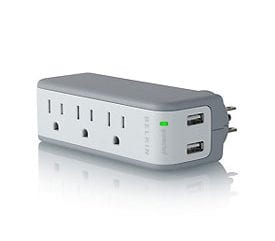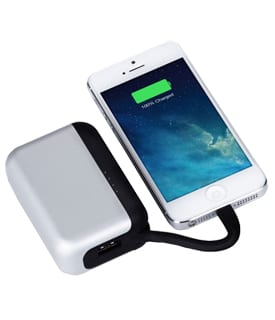
Rocket Yard Contributor Steve Sande is about to return from a fun adventure and has been providing readers with helpful tips over the past month that can help them use their tech gear confidently and safely anywhere.
Present Location: San Juan, Puerto Rico
We’re just a few short days away from returning to the USA and our home in Colorado. I hope that this series of posts has been useful to readers of The Rocket Yard, and that you’ll be able to use these as a starting point to prepare for your travels in the future. The other posts in this series include:
- Packing Tech For A Long Trip
- Apps You Should Install Before You Leave
- International Voice and Data Options
- Backups On The Road For Mac And iOS
- Using An iPad Pro As Your Primary “Laptop”
- Staying Safe on Public Wi-Fi Networks
- Physical Security For Your Mobile Devices
In these posts, I’ve assumed that your devices are all fully charged up and ready to go. Today, I’ll touch briefly on some items that are handy when you’re near a power outlet, then talk about ways to power your tech off the grid.
When You’re Near An Outlet

Most of the world has been electrified for many years, so even in the most desperate hotel in the middle of nowhere you can usually plug in to charge your gear. That doesn’t mean that there will be hundreds of plugs available; sometimes you’ll be lucky to find one in a room or you may need to share with others in a crowded airport waiting area.
For those situations, two items are helpful. First is a common multi-outlet power strip. It doesn’t even need to be equipped with surge protection, although that might be useful in those places with unstable power. The second? A multiple-outlet USB charger. The former piece of gear can make other people happy when you ask to use an outlet, while the latter can easily charge all of your iOS devices and many accessories at the same time.
But why pack two multiple-outlet strips when you can get both extra outlets and extra USB ports in one accessory? Some favorites that are sold at Macsales.com include the Belkin Mini Surge Protector with Integrated USB Charger (3 outlets, 2 USB ports, see image at right) and the KOPI Kbar Combo (also 3 outlets, 2 USB ports).
All Apple products run on a variety of AC voltages at either 50 or 60 Hz, which means that just plugging them into any outlet will power them with no issues. However, you might find that you’re literally trying to plug a rectangular prong into a round socket! A plug adapter like the Kanex Travel Bud or Macally Universal Power Plug Adapter with USB charger gives you the ability to plug your country’s standard plug into just about any outlet worldwide.
Sometimes your outlet won’t be in a hotel or restaurant — it’s going to be in a car. That’s where powering and recharging your devices from the car’s DC adapter can be useful. I’m a big fan of the NewerTech USB Car/Auto Dual Port Charger and have one in both of our cars. Both the driver’s iPhone and passenger’s iPad or iPhone can be charging simultaneously while heading down the road.
 Finally, don’t count on having a power plug available on an airplane, even though most airlines have installed them in premium seating and are even adding them to economy seats. As a frequent flyer and traveler, I’ve found that these plugs are frequently out of order. Instead, count on using your own power — a battery pack.
Finally, don’t count on having a power plug available on an airplane, even though most airlines have installed them in premium seating and are even adding them to economy seats. As a frequent flyer and traveler, I’ve found that these plugs are frequently out of order. Instead, count on using your own power — a battery pack.
There are many manufacturers of backup battery chargers so I won’t list them all here. But external chargers can be a lifesaver when your battery is running low, often providing several charges before the battery pack itself needs to be recharged.
Off The Grid
While my personal idea of adventure travel is to be on a luxury cruise ship in exotic places, it’s totally different for a lot of other people. When I was much younger, I did a lot of hiking and camping, and while the gadgets that we take for granted weren’t even invented then, having power at a campsite could have been quite useful.
Along with our gadgetry came some pretty sophisticated ways to charge up technological gizmos off the grid. Although my tent-camping days have been over for years, I still have many of the off-grid charging devices mentioned here in a survival bag for emergencies.
First, solar chargers are not only becoming common but more inexpensive than they used to be. They can range in size from a simple iPhone case to a portable solar array for charging a lot of gear. The portable arrays fold down into something you can carry in a backpack (or even strap on the outside for charging while hiking), and then unfold and hang from a tree or tent. iPhone solar cases are usually set up to just “top off” your battery in an emergency, but cases exist that flip open to reveal a larger solar panel to get you completely off the grid.
How about a wood-powered generator? I’m not making this up; there are solutions that allow campers to cook food to fuel themselves and get power for their gadgets at the same time. Some use thermocouples and the temperature differential between the inside and outside of a cook pot to generate electricity. Just having enough of a fire to boil water will usually produce enough power to quickly charge your devices.
Another device is a small wood-fired cook stove that uses forced air ventilation to create a smokeless fire that boils water or cooks your food quickly — and it generates electricity as well.
Conclusion
All of our technology doesn’t do a bit of good if it isn’t charged up, and there are ways to ensure that your devices will be ready to go when you need them. If you’re “on the grid”, make sure that you have plugs, adapters, and battery packs to keep you going, while going totally off the grid, you have a choice of solar and biomass combustion to provide power.
I hope you’ve enjoyed reading this series on traveling with tech as much as I have enjoyed writing it while journeying to Brazil, up and down the Amazon River, and through the Caribbean. May you have worry-free fun and excitement on your travels!










Steve, solar and biomass combustion to provide power should be used more often! Not just when of the grid! But, unfortunately, power plugs nowadays are way too available everywhere!